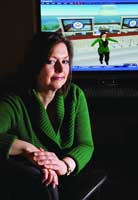At a briefing held by Rep. George Miller (D-Calif.) last month, one of the invited guests rose up from his seat, floated 15 feet into the air, flew around the chamber for a few minutes and then crashed into the ground near the podium.Security subdued the man, removed him from the House of Representatives chambers and the briefing continued without incident.Just another day on Capitol Hill'at least, the version of Capitol Hill untouched by human hands. Miller's office hosted the event on Second Life, a virtual world that is rapidly blurring the lines between real life and the digital world, or 'metaverse.'Miller and the 50 or so invited guests were avatars, cartoon representations that users name and design themselves. Avatars can fly, soar and hover with a click of the PageUp key, although maneuvering is sometimes clumsy.They communicate with one another through a chat feature. Second Life's House chamber was on a virtual island designed for Miller's office by Clear Ink of Berkeley, Calif. Like many buildings in Second Life, the chamber lacks a ceiling, allowing avatars to fly freely, unencumbered by roofs.The Second Life platform, or grid, was developed by Linden Lab of San Francisco in 2003. More than 2.6 million people have visited Second Life, which is free for visitors. Users can buy and sell real estate, clothing, jewelry, tattoos and all kinds of services using Second Life's own currency, the Linden dollar, which people can buy for a small fee; about one U.S. dollar will buy 300 Linden dollars.Like many in the corporate world, government agencies are exploring the possibilities of the Second Life landscape. If that's where citizens are, shouldn't government find a way to meet them on their turf? Even if that turf is virtual?An aide to Miller said Second Life was a way to collaborate with peers in an educational environment without being confined by geographical barriers.'You could be in the virtual Capitol Hill, watching a C-Span feed of the swearing-in ceremony of Nancy Pelosi, while having a side conversation with someone sitting next to you, even though they might be hundreds of miles away in the real world,' the aide said.It's this visual, spatial element that makes a meeting in Second Life so much more compelling than swapping e-mails.'After you've had a meeting in Second Life, whatever part of your brain that holds onto the memory of place will hold onto that more than a text-based chat or conference call,' said Steve Nelson, executive vice president and co-founder of Clear Ink.Miller's office encountered some technical roadblocks in setting up the virtual press conference, the aide to the congressman said. 'Access to Second Life is blocked from the U.S. Capitol, as is a lot of cutting-edge technology,' he said.The House's information security protocols 'blocked a lot of blogging software and wikis. We're woefully behind in our technological capabilities. The most august deliberative body in the world is operating off a [Microsoft Corp.] Exchange server from six years ago.'Second Life is also 'pretty demanding of your graphics card,' Nelson said. 'If you haven't had your computer upgraded since 1999, you're probably not getting on.'To access the virtual briefing, Miller and his staff had to use computers in a building across the street from the Capitol Hill campus.Miller is a member of the George Lucas Education Foundation, a nonprofit organization that promotes innovation in schools. GLEF approached Miller about holding a briefing on Second Life. Also involved in GLEF was John Gage, chief researcher at Sun Microsystems Inc. On Dec. 20, Gage asked Clear Ink if they could help set up the briefing for the opening session of Congress on Jan. 4.'So we had about two weeks to coordinate everything,' Nelson said. Fortunately, a lot of Clear Ink's clients were on vacation, so Nelson and his staff had some extra time. Nelson and Jon Brouchoud, a 3-D experience architect at Clear Ink, used an aerial photo of the Capitol Hill area from Google Earth to map out the design of the island. They put a small reflecting pool in front of the Capitol building, very much like the real one. On the way to the real briefing in Washington, Nelson looked out of his taxi window and saw the real reflecting pool, the one he had used to model his virtual version. 'It was a strange moment, seeing the real thing,' he said.Second Life charges $1,675 U.S. dollars for an island. Clear Ink bought two islands to create the virtual Capitol Hill. Rent for a month is $300, so Clear Ink is spending $600 a month to keep the two islands going. Visitors to the space can check out information kiosks and discuss issues such as the minimum wage using the chat feature.Second Life is still 'a coming-of-age story,' said Eric Hackathorn, an IT specialist with the National Oceanic and Atmospheric Administration's Earth System Research Laboratory in Boulder, Colo., which began building its Second Life island in April 2006.At the NOAA ESRL island, avatars can swim with dolphins, fly through real-time weather, climb a melting glacier, ride through a hurricane and experience a tsunami. Although NOAA's island wasn't officially open to the public until last month, in the first week it received 500 visitors, strictly through word of mouth, Hackathorn said.Second Life has its own integrated development environment called Moodle, which Hackathorn used to build much of the site. 'It's basically Web site software that's designed for teaching aids,' he said. Second Life also comes with a scripting package, Linden Scripting Language. The company is planning to switch to Mono, an open-source equivalent to Microsoft .Net.Now the NOAA island is an 'educationally themed amusement park,' Hack- athorn said, but the potential exists for it to give people more of a voice. Most federal Web sites use traditional media models and are very passive, he said. Second Life changes that by giving people more of a chance for active dialogue.Giving users this chance to be more reactive with government creates challenges, too, Hackathorn added. A group of avatars could decide to stage a demonstration on the island to protest the administration's climate policy. Events in Second Life are sometimes disrupted by griefers, ava- tars who seek to harass others or cause grief.Much like the TV weatherman played by Bill Murray in the 1993 movie 'Groundhog Day,' avatars in Second Life don't have to face the real consequences of their virtual actions, for the most part. No matter what happens, 'You can always hit Ctrl Q and quit,' Nelson said. It's not real life. Not yet, anyway.
ALTER EGO: GCN's Trudy Walsh created an avatar to visit Rep. George Miller's Second Life congressional site.
Zaid Hamid
Second Life is 'pretty demanding of your graphics card. If you haven't had your computer upgraded since 1999, you're probably not getting on.' Clear Ink's Steve Nelson







